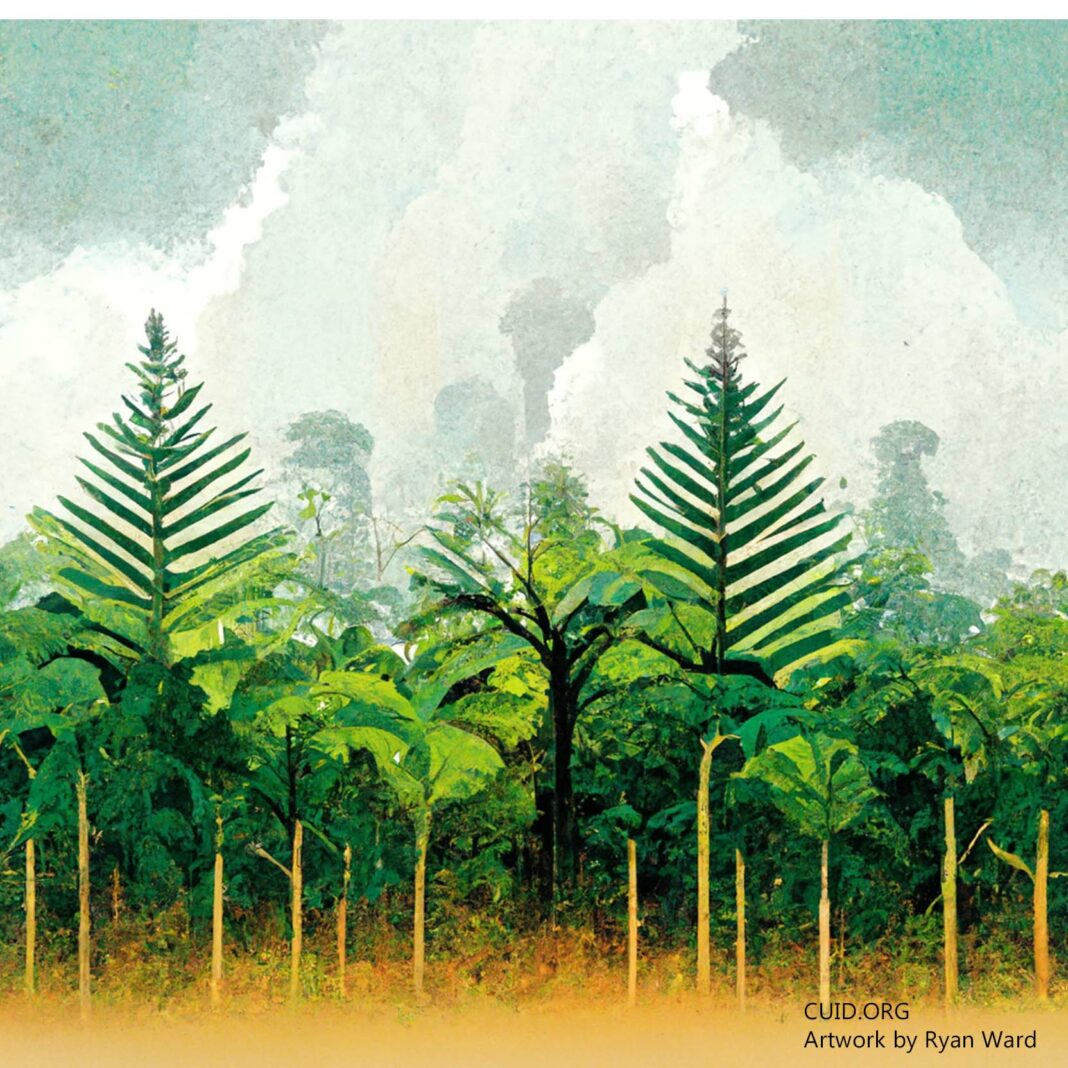Published by Ella Duffy, and artwork by Ryan Ward.
In 2009, an innovative project became the posterchild for the REDD+ programme (the United Nations Collaborative Programme on Reducing Emissions from Deforestation and Forest Degradation in Developing Countries, set up in 2008). Guyana, a country on the Caribbean coast of South America with an estimated 75-85% forest coverage[1], would be funded by Norway to conserve their vast expanses of rainforest. USD$250 million was promised to Guyana, to be paid on a results-led basis and invested in Guyana’s Low Carbon Development Strategy (LCDS) projects. There were seven original projects in the first years of the project, ranging from improving forest and biodiversity mapping to Amerindian land titling and micro-enterprise grants for rural communities. Ten years on and the agreement, which was only supposed to last five years, has shown little real progress and has had a limited effect on the indigenous communities who were supposed to benefit from the finances.
The REDD schemes are, in theory, a simple and effective way to curb deforestation, keeping rainforests as carbon sinks and reducing the volume of carbon dioxide emitted into the atmosphere. Governments and their forest-dwelling peoples are financially rewarded for not cutting down trees, and this money can be fed back into low-carbon development projects; this ‘peopled’ aspect of REDD schemes is denoted by the ‘+’ in ‘REDD+’. However, what this overview hides is that REDD programmes can al low richer countries to continue on a ‘business as usual’ trajectory domestically, whilst offsetting the emissions through prevented deforestation in the Global South. Another whole article could be written about the neocolonial undertones of this, but even ignoring the narrative behind it, there is surely an obvious problem if REDD is exploited in this way.
low richer countries to continue on a ‘business as usual’ trajectory domestically, whilst offsetting the emissions through prevented deforestation in the Global South. Another whole article could be written about the neocolonial undertones of this, but even ignoring the narrative behind it, there is surely an obvious problem if REDD is exploited in this way.
Norway’s interest in Guyana h therefore been suspected to be an attempt for Norway, the biggest REDD donor worldwide, to maintain its ‘green’ international image whilst remaining a major oil producer. The choice of Guyana as a funding partner is in itself odd. Norway’s two other major funding partners are Brazil and Indonesia, countries with historically incredibly high rates of deforestation where financial incentives could make real difference in willingness to participate in conservation. Guyana, on the other hand, seemed a strange choice, being roughly the size of the UK but home to only 784,000 people, and with an already extremely low annual deforestation rate compared to global figures (0.02% in 2009-2010 compared to the global average of 0.52% in 2005-2009). Norway had no previous bilateral ties with the country, and no previous political or commercial interests. Guyana is classified as lower-middle-income by the World Bank but, at the time of the REDD+ deal, was ranked in the Corruption Perception Index (Transparency International) as 133rd out of 180 countries, meaning it had a similar lack of government transparency and freedom of the press to Russia and Iran. Bade (2013) puts this strange choice down to ‘aid in a rush’. Norway was pushed for time before the Fifteenth session of the Conference of the Parties to the United Nations Climate Change Conference in Copenhagen in December 2009, so organised the deal without any kind of risk assessment until ten months after the agreement was signed.
This lack of clarity is characteristic of the project as a whole. The agreement between Guyana and Norway was first heralded as a potential model for REDD+ to be implemented globally and Bharrat Jagdeo, Guyana’s president at the time, was even nominated for a Nobel Peace Prize because of his environmental efforts. Despite the initial excitement over REDD+ in Guyana, however, the project was plagued by misunderstandings and slow progress. Finances have been slow to trickle through from the World Bank fund into which Norway pays, and the political momentum seems not to have been maintained through the 2015 change in presidency. A hydroelectric dam was supposed to be the first large development project funded through the scheme, but plans collapsed due to parliamentary opposition and private sector withdrawal. There is a silver lining: there has been significant progress in one of the seven original projects, and forest monitoring and biodiversity mapping has improved with Norway’s input.
A major player in the program is the indigenous population of Guyana. Roughly 10% of Guyana’s population is indigenous; Guyanese Amerindians are the majority population in all the hinterland regions. It is these hinterland regions with which REDD+ concerns itself, as much of the Guyanese hinterlands are virgin rainforest. Early conversations in the initial agreements were that Amerindian people would be fully communicated with and consulted at all stages of the REDD+ program. In addition, the program’s funds were mainly to be used on projects that benefited local communities, including a long-needed Amerindian land titling program.
An impact assessment from Laing (2018) reveals that nothing has really come of the REDD+ program for forest-dwelling Amerindian people. While there was talk early on in the project about having robust communication between Amerindians and the government, this seems to have been superficial and Amerindian communities were concerned about the lack of information given to them. There has been no significant cost to Amerindian communities through REDD+, but also no significant benefits; all that has materialized are a few grants of USD$25,000 and some solar panels. There were hopes of economic benefits to remote communities from REDD+, but slow implementation coupled with a long history of Amerindian mistrust towards the government has simply resulted in more scepticism about their commitment to Amerindian communities. Laing (2018) says that “it is neither a grand success or a complete failure” but that at least the initial excitement over REDD+ opened up potential political channels for more effective communication between Amerindian village councils and national government in the future.
It would seem, then, that Norway’s funding of Guyana, a country that already had very low levels of deforestation, may have been an ineffective choice in the first place, and that the REDD+ program has amounted to very little human development in the decade that it has been running. While the forest and biodiversity monitoring scheme has been successful, the on-the-ground development projects have not materialised and there has been a noticeable reduction in the commitment to proper communication with Amerindian communities. Aside from these issues with the implementation of the program, there are also conceptual issues with REDD itself. It is not in any way an effective program if the donor country uses it to ‘offset’ their own domestic emissions whilst staying on a ‘business as usual’ trajectory, as this amounts to no net gain in preserving forests at all.
Where does this leave Guyana? The rate of deforestation has risen in the last decade (but not extensively) and ecotourism has boomed. The government continues to pride themselves on backing environmentally focused policy. However, they will have increasingly more environmental issues to deal with in the coming years; not only will the low-lying country be affected by sea level rise with anthropogenic climate change, but also recently discovered offshore oil wells may provide opportunities for extractive industries to threaten Guyana’s ‘green’ reputation. As for REDD, schemes continue to be implemented globally, some with a great deal more success than this early version of the program in Guyana, but the question remains over whether they can provide more than just a carbon offsetting solution for richer nations.
[1] FAO, 2010; Guyana Forestry Commission & Indufor, 2012, 2013; Guyana Forestry Commission & Poyry Forest Industry, 2010.



